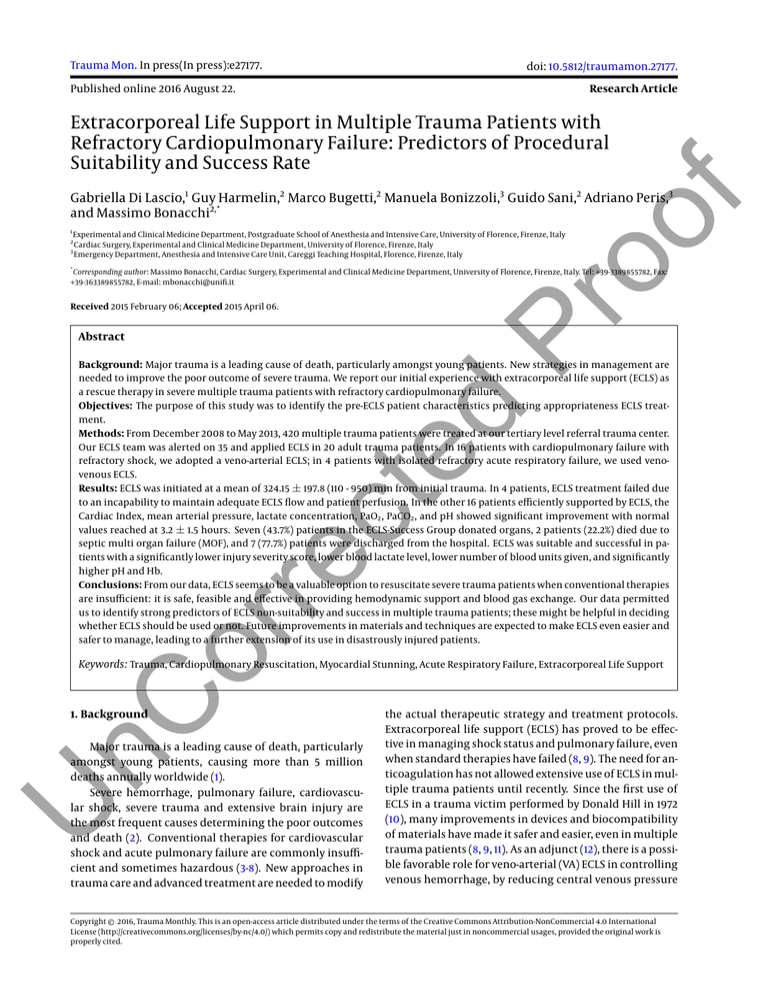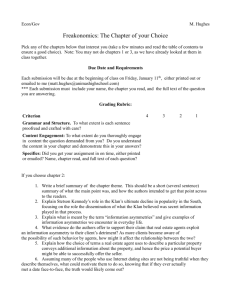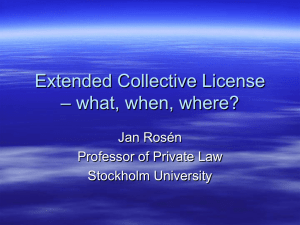Extracorporeal Life Support in Multiple Trauma Patients with
advertisement

Trauma Mon. In press(In press):e27177. doi: 10.5812/traumamon.27177. Published online 2016 August 22. Research Article Extracorporeal Life Support in Multiple Trauma Patients with Refractory Cardiopulmonary Failure: Predictors of Procedural Suitability and Success Rate 1 Pr oo f Gabriella Di Lascio,1 Guy Harmelin,2 Marco Bugetti,2 Manuela Bonizzoli,3 Guido Sani,2 Adriano Peris,3 and Massimo Bonacchi2,* Experimental and Clinical Medicine Department, Postgraduate School of Anesthesia and Intensive Care, University of Florence, Firenze, Italy Cardiac Surgery, Experimental and Clinical Medicine Department, University of Florence, Firenze, Italy Emergency Department, Anesthesia and Intensive Care Unit, Careggi Teaching Hospital, Florence, Firenze, Italy 2 3 * Corresponding author: Massimo Bonacchi, Cardiac Surgery, Experimental and Clinical Medicine Department, University of Florence, Firenze, Italy. Tel: +39-3389855782, Fax: +39-363389855782, E-mail: mbonacchi@unifi.it Received 2015 February 06; Accepted 2015 April 06. Abstract or re ct ed Background: Major trauma is a leading cause of death, particularly amongst young patients. New strategies in management are needed to improve the poor outcome of severe trauma. We report our initial experience with extracorporeal life support (ECLS) as a rescue therapy in severe multiple trauma patients with refractory cardiopulmonary failure. Objectives: The purpose of this study was to identify the pre-ECLS patient characteristics predicting appropriateness ECLS treatment. Methods: From December 2008 to May 2013, 420 multiple trauma patients were treated at our tertiary level referral trauma center. Our ECLS team was alerted on 35 and applied ECLS in 20 adult trauma patients. In 16 patients with cardiopulmonary failure with refractory shock, we adopted a veno-arterial ECLS; in 4 patients with isolated refractory acute respiratory failure, we used venovenous ECLS. Results: ECLS was initiated at a mean of 324.15 ± 197.8 (110 - 950) min from initial trauma. In 4 patients, ECLS treatment failed due to an incapability to maintain adequate ECLS flow and patient perfusion. In the other 16 patients efficiently supported by ECLS, the Cardiac Index, mean arterial pressure, lactate concentration, PaO2 , PaCO2 , and pH showed significant improvement with normal values reached at 3.2 ± 1.5 hours. Seven (43.7%) patients in the ECLS-Success Group donated organs, 2 patients (22.2%) died due to septic multi organ failure (MOF), and 7 (77.7%) patients were discharged from the hospital. ECLS was suitable and successful in patients with a significantly lower injury severity score, lower blood lactate level, lower number of blood units given, and significantly higher pH and Hb. Conclusions: From our data, ECLS seems to be a valuable option to resuscitate severe trauma patients when conventional therapies are insufficient: it is safe, feasible and effective in providing hemodynamic support and blood gas exchange. Our data permitted us to identify strong predictors of ECLS non-suitability and success in multiple trauma patients; these might be helpful in deciding whether ECLS should be used or not. Future improvements in materials and techniques are expected to make ECLS even easier and safer to manage, leading to a further extension of its use in disastrously injured patients. nC Keywords: Trauma, Cardiopulmonary Resuscitation, Myocardial Stunning, Acute Respiratory Failure, Extracorporeal Life Support 1. Background U Major trauma is a leading cause of death, particularly amongst young patients, causing more than 5 million deaths annually worldwide (1). Severe hemorrhage, pulmonary failure, cardiovascular shock, severe trauma and extensive brain injury are the most frequent causes determining the poor outcomes and death (2). Conventional therapies for cardiovascular shock and acute pulmonary failure are commonly insufficient and sometimes hazardous (3-8). New approaches in trauma care and advanced treatment are needed to modify the actual therapeutic strategy and treatment protocols. Extracorporeal life support (ECLS) has proved to be effective in managing shock status and pulmonary failure, even when standard therapies have failed (8, 9). The need for anticoagulation has not allowed extensive use of ECLS in multiple trauma patients until recently. Since the first use of ECLS in a trauma victim performed by Donald Hill in 1972 (10), many improvements in devices and biocompatibility of materials have made it safer and easier, even in multiple trauma patients (8, 9, 11). As an adjunct (12), there is a possible favorable role for veno-arterial (VA) ECLS in controlling venous hemorrhage, by reducing central venous pressure Copyright © 2016, Trauma Monthly. This is an open-access article distributed under the terms of the Creative Commons Attribution-NonCommercial 4.0 International License (http://creativecommons.org/licenses/by-nc/4.0/) which permits copy and redistribute the material just in noncommercial usages, provided the original work is properly cited. Di Lascio G et al. 2. Objectives Here we report our initial experience utilizing ECLS as a rescue therapy in severe trauma patients with refractory cardiogenic shock, cardiac arrest, and/or pulmonary failure. As others report (12, 13), the rationale for using ECLS in trauma patients is to treat refractory pulmonary and cardiopulmonary failure, providing adequate systemic perfusion, avoiding consequent multi-organ failure, and permitting organ recovery. Furthermore, we have identified several multiple trauma patient characteristics as predictors of the ECLS appropriateness. Furthermore, ECLS in selected multiple trauma patients can be used to support vital functions, giving time for adequate brain assessment and, eventually, organ donation (14, 15). Table 1. ECLS Techniques, Modalities, and Proceduresa ed 3. Methods all cases, a percutaneous cannulation procedure was carried out. Transthoracic/Transesophageal ultrasonography was performed to guide and evaluate cannula positioning and the definitive setting. In VA-ECLS cases, we adopted the femoro-femoral configuration; to prevent leg ischemia, a small shunt cannula (8 - 10 Fr) was inserted in the femoral artery, distally to the ECLS cannula. In VV-ECLS, we used two cannulas as the femoro-jugular setting (n = 2), or a single bi-lumen cannula (and only one jugular access, n = 2). In the case of VVECLS with the femoro-jugular setting, we used a previously reported original technique, the χ -configuration, to optimize extracorporeal blood oxygenation (17). In all cases, due to the actual or potential bleeding risk, we initially performed heparin-free extracorporeal support until the bleeding stopped and normalization of the patient’s coagulative status was achieved (Table 1). Pr oo f with active drainage from this site. Patient Characteristics (20 Patients) 3.1. ECLS Initiation U nC ECLS was initiated after a fast clinical and instrumental evaluation performed by the ECLS team members with ER staff. ECLS contraindications were advanced age (> 65/70 y), witnessed prolonged hypoxemia (e.g., prolonged inefficacious resuscitation on trauma theatre), potentially fatal pre-existing disease, and incontrollable major bleeding (e.g., aortic rupture). When possible (in 14 patients, 70% of total), we performed a total body CT scan prior to the decision regarding ECLS. The indication for VA-ECLS (n = 16 patients, 80%) was cardiopulmonary failure with shock (n = 4, 20%) or post-traumatic cardiac arrest (n = 12 patients, 60%), both refractory to conventional resuscitative treatment. Veno-venous (VV) ECLS (n = 4 patients, 20%) was indicated instead in patients with post-traumatic respiratory insufficiency with severe hypoxemia (PaO2 /FiO2 ratio of less than 100) or hypercapnic acidosis refractory to advanced mechanical ventilation management (Table 1). In 2 Values ECLS type VA 16 (80) VV 4 (20) Cannula insertion technique or re ct An ECLS program and an ECLS team have been deployed since 2006 in our institution (16). From December 2008 to May 2013, 420 multiple trauma patients were admitted to our hospital. The ECLS team was alerted for 35 (8.33%) of these. In 15 cases, ECLS was not started because several contraindications were found namely massive intractable bleeding (skeletal, retroperitoneal, aortic lesions, n = 9), prolonged hypoxemia (n = 2), and age (over 75 years, n = 4). The other 20 adult trauma patients (mean age 44.2 ± 16.2 years (range 15 - 69) and mean injury severity score 53.6 ± 17.2 (range 18 - 75)) underwent ECLS for refractory cardiopulmonary failure. Surgical 0 Percutaneous 20 (100) Cardiac arrest before ECLS Heparin administration delay from ECLS start, h 12 (60) 18.3 ± 19.4 Min-max 2.5 - 72 rfVIIa administration 13 (65) ECLS apply location Emergency room 6 (30) Operating room 2 (10) Intensive care unit 12 (60) Abbreviations: CVVH, continuous veno-venous hemofiltration; ECLS, extracorporeal life support; IABP: intra-aortic balloon pump; VA, veno-arterial; VV: venovenous. a Values are expressed as No. (%) or data mean ± SD. 3.2. ECLS Circuit The circuit used is “tip-to-tip” heparin coated and includes a special intake stopcock for large volume administration (PLS System, MAQUET Cardiopulmonary AG, Germany). Depending on the patient’s biometric data, we used a 21 or 23 Fr arterial cannula and a 25, 27, or 29 Fr venous cannula for VA and VV (in double cannulation setting) ECLS. Trauma Mon. In press(In press):e27177. Di Lascio G et al. For VV ECLS with a single cannula, we used a 29 or 31 Fr bilumen cannula. A heat exchanger device was integrated in the ECLS circuit to control the patient’s temperature. Table 2. Comparison of pre-ECLS Demographic, Clinical, Instrumental, and Laboratory Characteristics Between the Groups of ECLS-Success Patients (n = 16) and ECLSFailure Patients (n = 4) With Statistical Evaluation Resultsa Age, y Gender Male ECLS-Failure (4 Patients, 20%) P Value 42.7 ± 18.2 43 ± 19.7 0.97 75 50 Female 25 50 0.569 43.35 ± 18.5 65 ± 9.6 0.010 Cardiac arrest 43.7 100 0.082 Cardiac arrest, min 49.5 ± 26.7 78.7 ± 8.5 0.002 ECLS insertion location 75 ICU; 12.5 OR; 12.5% ER 100 ER 0.0042 ECLS type (VA vs VV) 12 (75) v-a; 4 (25) v-v 4 (100) VA 0.679 Heparin-free time on ECLS, h 21.89 ± 20.2 25.4 ± 13.8 0.703 12.5 0 0.8702 pH 7.13 ± 0.22 6.85 ± 0.11 0.005 PaO2 /FiO2 before ECLS 158.6 ± 97.8 177.5 ± 55 0.621 PaCO2 before ECLS, mmHg 52.95 ± 8.8 62.5 ± 7 0.0666 Blood lactates concentration, mmol/l 7.11 ± 5.26 18.6 ± 3 0.0008 Inotropic score, µg/kg/min 199.1 ± 52.8 307.5 ± 30.9 0.001 ISS ed Blood flow provided by ECLS was maintained in the range of physiologic cardiac output. The gas supply to the oxygenator was regulated to reach normal blood gas concentrations. Activated recombinant factor VII (rFVIIa) was administered in the case of refractory hemorrhage to give an adjunctive chance to control the bleeding (18); no clot formation in the circuit was observed after this procedure. If cardiopulmonary resuscitation was carried out before ECLS and brain injury was suspected, hypothermia was rapidly initiated and maintained for 48 hours at a temperature between 32 and 34°C (19). A Swan-Ganz catheter was inserted to evaluate the wedge pressure and SvO2 . Heparin administration was delayed in the case of bleeding, giving time for surgical hemostasis to be performed; it was started when the absence of active bleeding was confirmed, at 18.3± 19.4 [range 2.5 - 72] hours from ECLS deployment, and titrated by the bedside measurement of the activated partial thromboplastin time (aPTT, target value: 40 - 50 seconds) every two hours. During ECLS treatment, additional specific modules were added to the ECLS circuit when needed, renal (continuous venovenous hemofiltration (CVVH) n = 8) and hepatic (n = 2) function, or in the case of sepsis (endotoxin removal cartridge, n = 3) (20). Procedures performed during ECLS are summarized in Table 2. Patients were considered ready for weaning from VV-ECLS when the pump flow could be reduced to 1.5 - 2 L/min and an arterial SatO2 of at least 90% was maintained. Weaning from VA-ECLS was achieved with mild inotropic support, progressively reducing the ECLS flow and evaluating the cardiac ejection fraction by transesophageal ultrasonography. Successful weaning was considered weaning from ECLS followed by survival beyond 48 hours. Survival was defined as weaning from ECLS followed by discharge from the hospital. Inotropic Score was calculated by the following formula: Inotropic score (µg/kg/min): dosages of dopamine + dobutamine (µg/kg/min) + [dosages of epinephrine + norepinephrine + isoproterenol (µg g/kg/min)] × 100 + dosage of milrinone (µg/kg/min) × 15. ECLS-Success (16 Patients, 80%) Pr oo f Patient Characteristics 3.3. ECLS Management and Weaning U nC or re ct IABP 87.5 100 0.879 Blood units infused 12.67 ± 6.2 18.75 ± 3.3 0.023 Hemoglobin, g/dl 6.43 ± 0.54 5.35 ± 0.26 0.0005 Time trauma-ECLS, min 378.9 ± 263.5 385 ± 103.44 0.943 Time active bleeding min 205.2 ± 95.2 385 ± 103.4 0.004 rfVIIa administration 75 100% 0.765 rfVIIa administration during ECLS 50 10 0.184 Active bleeding Abbreviations: ECLS, extracorporeal life support; ER, emergency room; IABP, intra-aortic balloon pump; ICU, intensive care unit; ISS, injury severity score; OR, operating room; rfVIIa, recombinant factor VII activated. a Values are expressed as No. (%) or media ± SD or %. 3.4. Statistical Analysis All statistical analyses were performed with SPSS ver. 19.0 for Windows (SPSS Inc., Chicago, IL, USA). Categorical variables were expressed as percentages and were evaluated with the chi-square or Fisher’s exact test. Continuous variables were expressed as mean ± SD, minimum and Trauma Mon. In press(In press):e27177. maximum values reported between square brackets, and were evaluated by Student’s t-test or the Wilcoxon rank sum test. In addition, receiver operating characteristic (ROC) curves were used to dichotomize continuous vari3 Di Lascio G et al. used successively to identify independent predictors of unsuitability and unsuccessful ECLS treatment with univariate and multivariate analyses. Based on the ROC curves, the cut-off values were: for ISS > 63, CA > 60 minutes, pH < 7.01 (mean of last 3 evaluations), blood lactate (BL) > 14.4 mmol/l (mean of last 3 evaluations), IS > 270 µg/kg/min, total blood units > 22, Hb < 6.7 g/dL (mean of last 3 evaluations), bleeding time > 200 minutes. These dichotomized variables and emergency room ECLS implantation were significant predictors associated with ECLS treatment unsuitability and failure (Table 3). From these significant predictors, using multivariate regression analysis (Table 4), only ISS > 63 (OR = 4.27; CI = 1.37 - 13.31; P = 0.0407), pH < 7.01 (OR = 7.17; CI = 2.480 - 20.752; P = 0.0137) and BL > 14.4 mmol/L (OR = 12.51; CI = 4.47 - 34.97; P = 0.0251), were significantly associated with ECLS failure and individuated as strong predictors of ECLS unsuitability and failure. Pr oo f ables based on a cut-off value. Univariate and multivariate analyses have been used to determine the independent predictors of unsuitability and unsuccessful ECLS treatment. Univariate analysis was conducted using the chisquare or Fisher’s exact test (as appropriate) for categorical data and Student’s t-test or the Wilcoxon rank sum test (as appropriate) for measurement data. Potential predictors with P < 0.05 on univariate analysis were included in multivariate analysis, performed using stepwise logistic regression, to identify independent predictors. In the study of univariate and multivariate analyses, the values of odds ratios (ORs) and a confidence interval (CI) with a reliability of 95.0% were obtained for all significant predictors. All p-values are 2-tailed and a difference was considered significant when the P value was < 0.05. This study was approved by the institutional review board at the Experimental and Clinical Medicine Department - University of Florence, and at the emergency department, Careggi Teaching Hospital, Florence, Italy. 4. Results ed 4.2. ECLS Treatment Efficacy or re ct ECLS was deployed in 20 patients (57%) out of 35 ECLS team alerts. In 6 patients (30%), the ECLS device was implanted in the emergency room, in 2 (10%) in the operative room, and in 12 (60%) in the intensive care ward, according to their clinical status, in particular their hemodynamic and respiratory instability. ECLS was started at 324.15 ± 197.8 [110 - 950] minutes from the trauma. Cardiac arrest was observed in 12 patients before ECLS, and in 6 of these cases it was started during ACLS maneuvers. No complication during the cannulation procedure was observed (Table 1). In the ECLS-success group, the mean duration of the treatment was 102.5 ± 95 hours [24 - 384], with a significant longer support time needed for VV-ECLS (204 ± 28 hours), while in VA-ECLS the mean duration was shorter, 92.3 ± 113.8 hours (P = 0.018). During ECLS, damage control surgery was performed in 4 patients, with no bleeding complications. Arterial blood gases analysis (ABG), performed before ECLS and every 2 hours after the deployment, showed significant improvements of PaO2/FiO2 , PaCO2 , and pH, with normalization of all ABG values at 3.5 ± 1.5 hours [range 2 - 4] (Figure 2A). A comparable trend was registered in the mean arterial pressure, which was promptly enhanced by ECLS initiation (55.68 ± 12.45 to 73.45 ± 9.11 after 2 ± 1.2 hours, P < 0.0005). The inotropic score passed from 192.1 ± 50.6 to 115.68 ± 48.25 (P < 0.0005). A similar trend was recorded with regard to the BL concentration as well: prior to ECLS, the mean blood lactates concentration was 7.11 ± 5.26 [2.8 - 18.2] mmol/L; albeit only after 6 hours of ECLS initiation, there was a significant improvement in this value: 2.16 ± 1.38 [0.5 - 3.8] mmol/L (P = 0.004) (Figure 2B). In the case of ongoing renal, hepatic failure and sepsis, additional support was given to the patient, via the CVVH device (n = 8, 50%), plasmapheresis and detoxification device (n = 2, 12.5%), and endotoxin removal cartridge (n = 3, 18.7%). In 7 (43.7%) patients in the ECLS-success group with extensive cranio-cerebral trauma, ECLS was used with the purpose of saving time for brain death assessment and was continued just to support organ donation, which was potentially possible in all cases (100% effectiveness). One patient did not complete the organ donation procedure due 4.1. ECLS Success Versus ECLS Failure U nC In 4 (20%) patients, the ECLS-failure group, ECLS treatment failed due to the incapability to maintain adequate ECLS flow and patient perfusion. In 16 (80%) patients, the ECLS-success group, ECLS treatment was successful. The extracorporeal support was maintained until the treatment objectives were obtained or the patient’s death occurred. The differences in demographics, clinical, instrumental, and laboratory characteristics between the groups was analyzed and is reported in Table 2: the patients with ECLSfailure presented significantly higher values of the injury severity score (ISS), cardiac arrest (CA) duration and inotropic score (IS). In addition, to simplify pre-implantation patients’ evaluation of the pre-ECLS parameters tested, ROC curves were used to dichotomize continuous variables based on a cut-off value, corresponding with the highest Youden index (Figure 1). These cut-off values were 4 Trauma Mon. In press(In press):e27177. Di Lascio G et al. Table 3. Univariate Analysis Revealed the Following Pre-ECLS Implantation Patient Characteristics for ECLS Failure (Predictors of ECLS Unsuitability) OR 95% CI Z Statistic P Value ISS > 63 1.8 1.193 - 2.724 2.088 0.037 Cardiac Arrest > 60 min 2.96 1.258 - 6.951 2.102 0.035 ER application 4.5 pH < 7.01 (mean of last 3 evaluations) 1.8 Lactate > 14.4 mmol/L (mean of last 3 evaluations) 3.9 IS > 270 µg/kg/min 8.1 Total blood units > 22 7.2 Hb < 6.7 g/dL (mean of last 3 evaluations) 7.8 6 Bleeding time > 200 min Pr oo f Patient Data 1.258 - 6.951 2.316 0.0206 1.193 - 2.715 2.088 0.037 1.860 - 8.177 2.360 0.0183 2.775 - 23.643 2.553 0.0107 1.09 - 25.019 2.345 0.0221 1.04 - 5.819 2.276 0.0168 0.97 - 5.365 2.012 0.0234 Abbreviations: ER, Emergency room; ISS, Injury severity score; IS, Inotropic score (IS, µg/kg/min= dopamine + dobutamine + 15 × milrinone + 100 × epinephrine + 100 × norepinephrine + 100 × isoprotenolol). Table 4. Multivariate Analysis (Multivariate Logistic Regression Stepwise Model) of Significant Predictors Associated With ECLS Failure Revealed By Univariate Analysis ISS > 63 pH < 7.01 (mean of last 3 evaluations) SEM Odds Ratio 95% CI P Value 1.45273 0.1754 4.2748 1.373 - 13.314 0.0407 1.97044 0.1716 7.1738 2.480 - 20.752 0.0137 2.52623 0.69933 12.5063 4.473 - 34.974 0.0251 or re ct Blood lactates > 14.4 mmol/L (mean of last 3 evaluations) Regression Coefficient ed Patient Data Abbreviations: CI, confidence interval; ISS, injury severity score; SEM, standard error of arithmetic mean. U nC to opposition of relatives. The liver from all other patients (n = 6) and 3 kidneys were donated. Among the 9 (56.2% of the ECLS-success group) remaining patients, 2 (22.2%) patients died during the ECLS course due to septic multi-organ failure (MOF) (at days 7 and 16 of treatment), and 7 (77.7%) survived to discharge. All survivors were discharged from the ICU and to hospital wards and followed the necessary rehabilitative programs available. ECLS-related complications were observed in 2 patients: 1 leg ischemia due to femoral artery cannulation and 1 oxygenator failure due to clot formation (after 13 days of usage). The first was promptly solved by moving vascular access to the axillary artery, and the second complication was detected early enough via continuous monitoring. It was corrected by substituting the membrane lung. The ECLS-success group’s results and complications are summarized in Table 5. 5. Discussion Since the first pioneering experience in which ECLS was applied in a trauma victim in 1971 (10), many advances in Trauma Mon. In press(In press):e27177. technology, materials, and intensive care have occurred (9). The use of ECLS in cardiogenic shock and pulmonary failure of different etiologies is now accepted, and a new group of indications is being considered. Mortality rates due to major trauma are still high, despite intensive treatments. Recently, the first experiences of ECLS in trauma care have been reported (4, 13) with encouraging outcomes, suggesting that ECLS seems to be a valid option in severe trauma patients with refractory cardiopulmonary failure, preventing potentially evolving shock, maintaining tissue perfusion, oxygenation and organs function. Actual ECLS devices are small and portable, suitable for both intra and inter-hospital transport, easy, fast, and safe to implant, even in an “out-of-hospital” scenario (21). Thanks to improved biocompatibility, in our and from other authors’ experience (4), anticoagulation can be safely delayed for 48/72 hours. Anticoagulation can be maintained on mild levels, reducing bleeding complications (2). All these important advantages have made ECLS a safe and feasible technique (8, 9). Our study presents a specific category of multiple trauma patients with extremely severe clinical conditions and refractory cardiopulmonary failure. The mortality was 5 Di Lascio G et al. ed Pr oo f Figure 1. Pre-ECLS Parameters Tested by ROC Curves to Recognized a Cut-Off Value (Criterion), Corresponding With the Highest Youden Index, for all the Significant Different Parameters Between ECLS-Failure and ECLS-Success Groups or re ct In the boxes, the sensitivity, specificity, and criterion are reported for all parameters tested. (ISS, Injury severity score; CA, cardiac arrest duration (minute); pH, the value is the mean of last per ECLS-start 3 evaluations; BL, blood lactate concentration, the value is the mean of last per ECLS-start 3 evaluations (mmol/L), IS = Inotropic score (µg/kg/min), BU, total blood units infused pre ECLS-start; Hb, hemoglobine blood concentration, the value is the mean of last per ECLS-start 3 evaluations(g/dL); BT, bleeding time pre ECLS-start (min). nC predicted from the ISS score (mean, 53 ± 17) and prolonged CPR was > 90%. Thus, clearly, the application of ECLS to these very critical patients, as seen by the results of our study, can reduce mortality to a less-unacceptable 56.25% (9 deaths over 16 patients, considering the ECLS-success group) with the possibility of organ recovery for donation. Reported parameters and statistical analysis strengthen these results, confirming, as reported by other authors as well (4, 13), that ECLS is effective in rapidly improving both respiratory and hemodynamic function. U However, the clinical limitations and suitability of ECLS treatment is yet to be seen in this category of patients (4, 13). To date, there is no identified and reported predictor of ECLS success based on pre-implant patients’ clinical status. The identification of predictors for ECLS unsuitability and failure could result in a better identification of patients with greater efficacy and a better allocation of resources and cost-effectiveness. By focusing on the ECLSsuccess analysis, we tried to evaluate pre-implant parameters in patients who were too injured for ECLS and in which ECLS could not work. We considered all the accessible clinical, instrumental, and laboratory parameters in an emergency setting and that did not require invasive procedures 6 or time-consuming measurements: the data can be evaluated within minutes after emergency room patients’ access. To make the evaluation as simple and as fast as possible, all continuous variables were dichotomized by ROC curves for the estimation of cut-off values with the best sensibility and specificity. From our data, the univariate and multivariate statistical analyses identified the following parameters with the highest negative impact: BL > 14.4 mmol/L and pH < 7.01 among laboratory values, and ISS > 63 among clinical data. Interestingly, no ultrasonography or hemodynamic parameter contributed significantly to the prediction of ECLS success or failure. Cardiac arrest as a predictor was relatively significant (upon univariate analysis but not multivariate) only if persisting over 60 minutes. These results seem to suggest that ECLS should be avoided when tissue perfusion is strongly impaired for a long time, as such patients are likely to have entered into the irreversible stage of shock, dominated by disseminated intravascular coagulation and severely altered permeability of the microcirculation (22). From our experience, in this advanced shock stage it is impossible, even with ECLS, to interrupt the vicious cycle of hemorrhagic shock, blood acidosis, coagulopathy, and inadequate tissue perfusion Trauma Mon. In press(In press):e27177. Di Lascio G et al. nC or re ct ed Pr oo f Figure 2. A, ECLS-Success Group; B, ECLS-Success Group U The graph shows the arterial blood gases analysis parameters from the pre-ECLS time to 12 hours left. The connection draws (with P values) were between pre-ECLS and the first significant different value for any parameter. The values are express as mean ± SD. (ECLS, Extracorporeal life support; pCO2 , pre-ECLS value is the mean of at least 3 evaluations, (mmHg); pO2 /FiO2 , pre-ECLS value is the mean of at least 3 evaluations; pH, pre-ECLS value is the mean of at least 3 evaluations; p is referred to the first statistically significant variation of each parameter from ECLS-start). The graph shows the hemodynamic parameters from the ore-ECLS time to 12 hours left. The connection draws (with P values) were between pre-ECLS and the first significant different value for any parameter. The values are express as mean ± SD. (ECLS, extracorporeal life support, pre-ECLS value is the mean of at least 3 evaluations; IS, inotropic score, pre-ECLS value is the mean of at least 3 evaluations(µg/kg/min); MAP, Mean arterial pressure, pre-ECLS value is the mean of at least 3 evaluations (mmHg); BL, blood lactates, pre-ECLS value is the mean of at least 3 evaluations (mmol/L); P value is referred to the first statistically significant variation of each parameter from ECLS-start). and oxygen supply. ECLS has always been considered the last option, and has been deployed in those patients in which maximal advanced therapies had been exhausted, with no improvement. ECLS is a safe and feasible technique. It has proven to Trauma Mon. In press(In press):e27177. be lifesaving in multiply injured patients with refractory cardiopulmonary failure when it is promptly initiated in a specialized center. In our view, advanced management of multiple trauma patients should include ECLS in the case of refractoriness of the clinical conditions to conventional 7 Di Lascio G et al. Patient Characteristics Value ECLS modality VV-ECLS VA-ECLS On ECLS time, h Max-min VV-ECLS time, h Max-min VA-ECLS time, h Max-min Damage control surgery IABP 4 (20) 16 (80) 102.5 ± 95 24 - 384 204 ± 28 165 - 231 92.3 ± 113.8 24 - 384 4 (25) 2 (12.5) Adjunctive treatment modules 8 (50) Endotoxin removal cartridge 3 (18.7) Hepatic Complications Leg ischemia Oxygenator failure 1. Krug EG, Sharma GK, Lozano R. The global burden of injuries. Am J Public Health. 2000;90(4):523–6. [PubMed: 10754963]. 2. Probst C, Zelle BA, Sittaro NA, Lohse R, Krettek C, Pape HC. Late death after multiple severe trauma: when does it occur and what are the causes?. J Trauma. 2009;66(4):1212–7. doi: 10.1097/TA.0b013e318197b97c. [PubMed: 19359940]. 3. Spahn DR, Rossaint R. Coagulopathy and blood component transfusion in trauma. Br J Anaesth. 2005;95(2):130–9. doi: 10.1093/bja/aei169. [PubMed: 15964891]. 4. Arlt M, Philipp A, Voelkel S, Rupprecht L, Mueller T, Hilker M, et al. Extracorporeal membrane oxygenation in severe trauma patients with bleeding shock. Resuscitation. 2010;81(7):804–9. doi: 10.1016/j.resuscitation.2010.02.020. [PubMed: 20378236]. 5. Hemmila MR, Napolitano LM. Severe respiratory failure: advanced treatment options. Crit Care Med. 2006;34(9 Suppl):S278–90. doi: 10.1097/01.CCM.0000233788.96388.D8. [PubMed: 16917433]. 6. Rico FR, Cheng JD, Gestring ML, Piotrowski ES. Mechanical ventilation strategies in massive chest trauma. Crit Care Clin. 2007;23(2):299–315. doi: 10.1016/j.ccc.2006.12.007. [PubMed: 17368173] xi. 7. Cohn SM. Pulmonary contusion: review of the clinical entity. J Trauma. 1997;42(5):973–9. [PubMed: 9191684]. 8. Beckmann A, Benk C, Beyersdorf F, Haimerl G, Merkle F, Mestres C, et al. Position article for the use of extracorporeal life support in adult patients. Eur J Cardiothorac Surg. 2011;40(3):676–80. doi: 10.1016/j.ejcts.2011.05.011. [PubMed: 21683610]. 9. Bartlett RH, Gattinoni L. Current status of extracorporeal life support (ECMO) for cardiopulmonary failure. Minerva Anestesiol. 2010;76(7):534–40. [PubMed: 20613694]. 10. Hill JD, O’Brien TG, Murray JJ, Dontigny L, Bramson ML, Osborn JJ, et al. Prolonged extracorporeal oxygenation for acute posttraumatic respiratory failure (shock-lung syndrome). Use of the Bramson membrane lung. N Engl J Med. 1972;286(12):629–34. doi: 10.1056/NEJM197203232861204. [PubMed: 5060491]. 11. Larsson M, Talving P, Palmer K, Frenckner B, Riddez L, Broome M. Experimental extracorporeal membrane oxygenation reduces central venous pressure: an adjunct to control of venous hemorrhage?. Perfusion. 2010;25(4):217–23. doi: 10.1177/0267659110375864. [PubMed: 20573652]. 12. Cordell-Smith JA, Roberts N, Peek GJ, Firmin RK. Traumatic lung injury treated by extracorporeal membrane oxygenation (ECMO). Injury. 2006;37(1):29–32. doi: 10.1016/j.injury.2005.03.027. [PubMed: 16243331]. 13. Huang YK, Liu KS, Lu MS, Wu MY, Tsai FC, Lin PJ. Extracorporeal life support in post-traumatic respiratory distress patients. Resuscitation. 2009;80(5):535–9. doi: 10.1016/j.resuscitation.2009.02.016. [PubMed: 19362409]. 2 (12.5) 1 (6.2) 1 (6.2) or re ct Outcome References ed CVVH tion of data: Gabriella Di Lascio, Guy Harmelin, Marco Bugetti; analysis and interpretation of data: Massimo Bonacchi, Gabriella Di lascio, Guy Harmelin; drafting of the manuscript: Massimo Bonacchi, Gabriella Di lascio, Guy Harmelin, Marco Bugetti; critical revision of the manuscript for important intellectual content: Massimo Bonacchi, Guido Sani, Adriano Peris; statistical analysis: Massimo Bonacchi, Guy Harmelin; administrative, technical, and material support: Adriano Peris, Guido Sani; study supervision: Massimo Bonacchi, Adriano Peris, Guido Sani. Pr oo f Table 5. ECLS-Success Group: Modalities, Results, Complications, and Outcomea Cerebral death and organ donation 7 (43.7) Death due to septic MOF 2 (12.5) Survival 7 (43.7) Abbreviations: CVVH, continuous veno-venous hemofiltration; ECLS, extracorporeal life support; IABP, intra-aortic balloon pump. a Values are expressed as No. (%) or mean ± SD. U nC treatments and if no predictor of ECLS failure is present. Our data have permitted the identification of strong predictors of ECLS non-suitability and success in multiple traumapatients: these might be helpful in deciding whether ECLS should be implanted, explicitly in patients who are severely complex and compromised. Because ECLS does not impede conventional therapies, it should be instituted early alongside them, not only to give the patient the maximal chance of survival, but also as a new way of expanding the donor pool for organ transplantation. Future improvements in materials and techniques are expected to make ECLS even easier and safer to manage, leading to a further extension of its use in disastrously injured patients. Footnote Authors’ Contribution: Study concept and design: Massimo Bonacchi, Guido Sani, Adriano Peris; acquisi8 Trauma Mon. In press(In press):e27177. Di Lascio G et al. 20. 21. 22. Pr oo f 19. combinant factor VII for refractory bleeding during extracorporeal membrane oxygenation. Pediatr Crit Care Med. 2010;11(1):98–102. doi: 10.1097/PCC.0b013e3181b0620b. [PubMed: 19561557]. Polderman KH. Hypothermia and neurological outcome after cardiac arrest: state of the art. Eur J Anaesthesiol Suppl. 2008;42:23–30. doi: 10.1017/S026502150700333X. [PubMed: 18289413]. Cruz DN, Antonelli M, Fumagalli R, Foltran F, Brienza N, Donati A, et al. Early use of polymyxin B hemoperfusion in abdominal septic shock: the EUPHAS randomized controlled trial. JAMA. 2009;301(23):2445– 52. doi: 10.1001/jama.2009.856. [PubMed: 19531784]. Lebreton G, Pozzi M, Luyt CE, Chastre J, Carli P, Pavie A, et al. Out-of-hospital extra-corporeal life support implantation during refractory cardiac arrest in a half-marathon runner. Resuscitation. 2011;82(9):1239–42. doi: 10.1016/j.resuscitation.2011.04.002. [PubMed: 21536365]. Gando S, Sawamura A, Hayakawa M. Trauma, shock, and disseminated intravascular coagulation: lessons from the classical literature. Ann Surg. 2011;254(1):10–9. doi: 10.1097/SLA.0b013e31821221b1. [PubMed: 21368657]. U nC or re ct ed 14. Magliocca JF, Magee JC, Rowe SA, Gravel MT, Chenault R2, Merion RM, et al. Extracorporeal support for organ donation after cardiac death effectively expands the donor pool. J Trauma. 2005;58(6):1095–101. [PubMed: 15995454] discussion 1101-2. 15. Hsieh CE, Lin HC, Tsui YC, Lin PY, Lin KH, Chang YY, et al. Extracorporeal membrane oxygenation support in potential organ donors for brain death determination. Transplant Proc. 2011;43(7):2495–8. doi: 10.1016/j.transproceed.2011.06.027. [PubMed: 21911111]. 16. Ciapetti M, Cianchi G, Zagli G, Greco C, Pasquini A, Spina R, et al. Feasibility of inter-hospital transportation using extra-corporeal membrane oxygenation (ECMO) support of patients affected by severe swine-flu(H1N1)-related ARDS. Scand J Trauma Resusc Emerg Med. 2011;19:32. doi: 10.1186/1757-7241-19-32. [PubMed: 21619644]. 17. Bonacchi M, Harmelin G, Peris A, Sani G. A novel strategy to improve systemic oxygenation in venovenous extracorporeal membrane oxygenation: the "chi-configuration". J Thorac Cardiovasc Surg. 2011;142(5):1197–204. doi: 10.1016/j.jtcvs.2011.01.046. [PubMed: 21397257]. 18. Niebler RA, Punzalan RC, Marchan M, Lankiewicz MW. Activated re- Trauma Mon. In press(In press):e27177. 9





